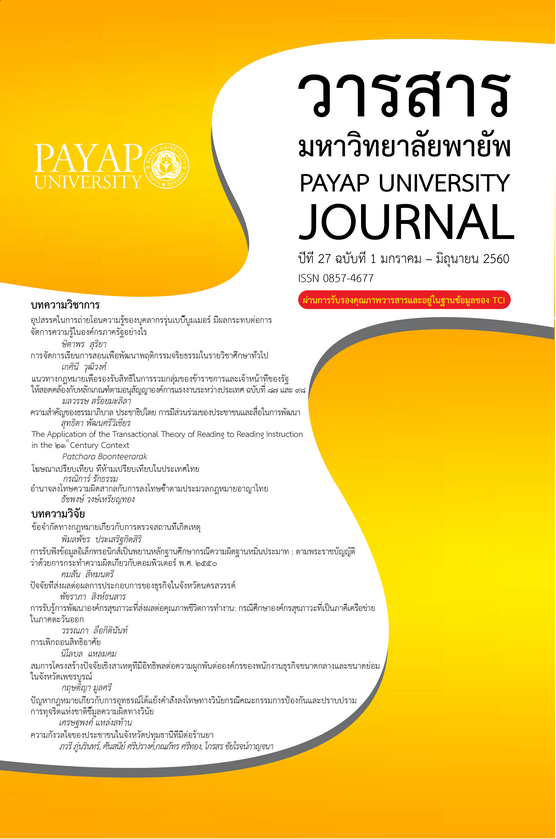ข้อจำกัดทางกฎหมายเกี่ยวกับการตรวจสถานที่เกิดเหตุทางอาญา
Main Article Content
บทคัดย่อ
การวิจัยนี้ มีวัตถุประสงค์เพื่อศึกษาข้อจำกัดทางกฎหมายที่ส่งผลต่อปัญหาและอุปสรรคของการ ปฏิบัติงานด้านการตรวจสถานที่เกิดเหตุทางอาญาของประเทศไทย งานวิจัยศึกษาการปฏิบัติงานด้านการตรวจ สถานที่เกิดเหตุทางอาญาของต่างประเทศ และศึกษาแนวทางในการพัฒนากฎหมายด้านการตรวจสถานที่เกิด เหตุทางอาญาอย่างเป็นมาตรฐานสากล งานวิจัยนี้อาศัยระเบียบวิธีวิจัยโดยศึกษาเอกสารทางกฎหมายที่เกี่ยวข้อง และสัมภาษณ์เชิงลึก
ผลการวิจัยพบว่า ตามกฎหมายและระเบียบการตำรวจเกี่ยวกับคดีได้กำหนดให้อำนาจหน้าที่ในการ สืบสวนสอบสวน เก็บรวบรวมพยานหลักฐานและการตรวจสถานที่เกิดเหตุแก่พนักงานสอบสวนเพียงผู้เดียว นอกจากนี้กรณีพบศพในที่เกิดเหตุ กฎหมายก็ได้ให้อำนาจแก่เจ้าพนักงานในการตรวจสถานที่เกิดเหตุแต่ เจ้าหน้าที่พิสูจน์หลักฐานนั้น กฎหมายมิได้บัญญัติให้อำนาจหน้าที่ในการตรวจสถานที่เกิดเหตุแต่อย่างใด ทำให้ เจ้าหน้าที่พิสูจน์หลักฐานไม่มีอำนาจหน้าที่ในการตรวจสถานที่เกิดเหตุได้เอง นอกจากพนักงานสอบสวนจะใช้ ดุลพินิจร้องขอโดยแจ้งให้เจ้าหน้าที่พิสูจน์หลักฐานเข้ามาตรวจสถานที่เกิดเหตุร่วมกับพนักงานสอบสวนด้วย เจ้าหน้าที่พิสูจน์หลักฐานจึงอยู่ในฐานะเป็นผู้สนับสนุนงานสอบสวน ในทางปฏิบัติพนักงานสอบสวนไม่ค่อยร้อง ขอให้เจ้าหน้าที่พิสูจน์หลักฐานมาตรวจสถานที่เกิดเหตุ จึงทำให้การเก็บรวบรวมพยานหลักฐานไม่ถูกต้องสมบูรณ์ตามกฎหมาย เมื่อคดีขึ้นสู่ศาลก็จะถูกยกฟ้องจากการขาดพยานหลักฐานอันนำไปสู่ความไม่เป็นธรรมใน กระบวนการยุติธรรม
ดังนั้นจึงมีข้อเสนอแนะให้มีการพัฒนากฎหมายด้านการตรวจสถานที่เกิดเหตุ โดยควรบัญญัติให้อำนาจ หน้าที่แก่เจ้าหน้าที่พิสูจน์หลักฐานในการตรวจสถานที่เกิดเหตุ เพื่อให้เจ้าหน้าที่พิสูจน์หลักฐานซึ่งเป็นผู้มีความรู้ ความเชี่ยวชาญและประสบการณ์ได้ทำการตรวจสถานที่เกิดเหตุได้อย่างเต็มที่ อันจะน่าไปสู่การคลี่คลายคดีได้ อย่างมีประสิทธิภาพเกิดความเป็นธรรมต่อลังคม
Article Details
เอกสารอ้างอิง
ไทพีศรีนิวัติ ภักดีกุล. (2547). การตรวจหาพยานหลักฐานจากสถานที่เกิดเหตุ. เขียงใหม่: คณะสังคมศาสตร์. นพคุณ กีรติการกุล. (2553). นิติวิทยาศาสตร์ตำรวจ. เขียงใหม่: บริษัทรัฐพงษ์-เอกลักษณ์ จำกัด.
พัชรา สินลอยมาและอื่นๆ. (2555). การพัฒนาประสิทธิภาพการอำนวยความยุติธรรมของสำนักงานตำรวจ แห่งขาติให้กับประขาขนด้านการรวบรวมพยานหลักฐานและการพิสูจน์หลักฐาน. สืบค้นวันที่ 23 พฤษภาคม 2559, จาก http://elibraiy.trf.or.th/project_content.asp?PJID=RDG5440013
วีระ วัฒนซัยนันท์. (2540). การสอบสวนภาคปฏิบัติ เล่ม 1. ม.ป.ท.
ศักดิ์ชัย อัศวินอานันท์. (2555). คู่มือการใข้พยานหลักฐานทางนิติวิทยาศาสตร์สำหรับพนักงานอัยการ. กรุงเทพฯ: บริษัทเอสแอลพลับบลิเคซั่นจำกัด.
สำนักงานพิสูจน์หลักฐานตำรวจ. คู่มือการตรวจสถานที่เกิดเหตุ. สืบค้นเมื่อ 5 มีนาคม 2559. http://www.forensic.police.go.th/
Barry A. J. Fisher. (2003). Techniques of Crime Scene Investigation. California.
James and Nordby. (2009). Forensic Science.
Kevin Lothridge. (2013). Crime Scene Investigation.
Michael M. Berlin. (2011). Crime Scene Searches and the Fourth Amendment. Investigative sciences journal.


